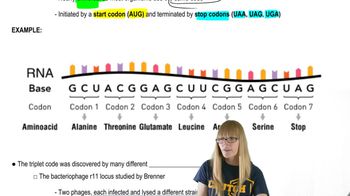The flow of genetic information from DNA to protein is mediated by messenger RNA. If you introduce short DNA strands (called antisense oligonucleotides) that are complementary to mRNAs, hydrogen bonding may occur and 'label' the DNA/RNA hybrid for ribonuclease-H degradation of the RNA. One study [Lloyd et al. (2001). Nucl. Acids Res. 29:3664–3673] compared the effect of different-length antisense oligonucleotides upon ribonuclease-H–mediated degradation of tumor necrosis factor (TNFα) mRNA. TNFα exhibits antitumor and pro-inflammatory activities. The following graph indicates the efficacy of various-sized antisense oligonucleotides in causing ribonuclease-H cleavage. What general conclusion can be drawn from the graph?
Table of contents
- 1. Introduction to Genetics51m
- 2. Mendel's Laws of Inheritance3h 37m
- 3. Extensions to Mendelian Inheritance2h 41m
- 4. Genetic Mapping and Linkage2h 28m
- 5. Genetics of Bacteria and Viruses1h 21m
- 6. Chromosomal Variation1h 48m
- 7. DNA and Chromosome Structure56m
- 8. DNA Replication1h 10m
- 9. Mitosis and Meiosis1h 34m
- 10. Transcription1h 0m
- 11. Translation58m
- 12. Gene Regulation in Prokaryotes1h 19m
- 13. Gene Regulation in Eukaryotes44m
- 14. Genetic Control of Development44m
- 15. Genomes and Genomics1h 50m
- 16. Transposable Elements47m
- 17. Mutation, Repair, and Recombination1h 6m
- 18. Molecular Genetic Tools19m
- 19. Cancer Genetics29m
- 20. Quantitative Genetics1h 26m
- 21. Population Genetics50m
- 22. Evolutionary Genetics29m
11. Translation
Translation
Problem 38a
Textbook Question
Organisms of all three domains of life usually use the mRNA codon AUG as the start codon.
Do organisms of the three domains use the same amino acid as the initial amino acid in translation? Identify similarities and differences.
 Verified step by step guidance
Verified step by step guidance1
Understand that the start codon AUG is universally recognized in all three domains of life (Bacteria, Archaea, and Eukarya) as the signal to initiate translation.
Recall that the AUG codon codes for the amino acid methionine (Met) in most cases, but the form of methionine used as the initial amino acid can vary between domains.
In Bacteria, the initial methionine is a modified form called N-formylmethionine (fMet), which is specifically used for the initiation of protein synthesis.
In Archaea and Eukarya, the initial methionine is not formylated; instead, it is a regular methionine (Met) that is incorporated at the start of translation.
Summarize the similarity: all three domains use AUG as the start codon and methionine as the initial amino acid. Highlight the difference: Bacteria use N-formylmethionine (fMet), while Archaea and Eukarya use unmodified methionine (Met).
 Verified video answer for a similar problem:
Verified video answer for a similar problem:This video solution was recommended by our tutors as helpful for the problem above
Video duration:
3mPlay a video:
Was this helpful?
Key Concepts
Here are the essential concepts you must grasp in order to answer the question correctly.
Start Codon
The start codon, AUG, is a specific sequence in mRNA that signals the beginning of translation. It codes for the amino acid methionine in eukaryotes and archaea, while in bacteria, it can also code for a modified form called N-formylmethionine. Understanding the role of the start codon is crucial for grasping how protein synthesis initiates across different organisms.
Recommended video:
Guided course

Translation initiation
Translation Initiation
Translation initiation is the first step in protein synthesis, where the ribosome assembles around the mRNA and the first tRNA molecule binds to the start codon. This process varies slightly among the three domains of life—bacteria, archaea, and eukaryotes—due to differences in ribosomal structure and initiation factors, which can affect the initial amino acid incorporated into the growing polypeptide chain.
Recommended video:
Guided course

Translation initiation
Amino Acids and Genetic Code
Amino acids are the building blocks of proteins, and the genetic code determines how sequences of nucleotides in mRNA are translated into amino acids. While AUG universally codes for methionine in eukaryotes and archaea, bacteria use it to code for N-formylmethionine, highlighting both similarities and differences in the translation process across the three domains of life.
Recommended video:
Guided course

The Genetic Code

 7:58m
7:58mWatch next
Master Translation initiation with a bite sized video explanation from Kylia
Start learningRelated Videos
Related Practice
Textbook Question
476
views
